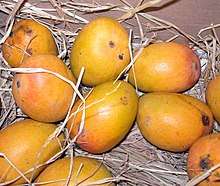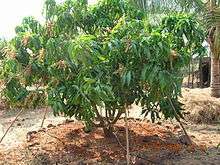Alphonso (mango)
The 'Alphonso' mango is a named mango cultivar that originated in India.[1]
| Mangifera 'Alphonso' | |
|---|---|
 'Alphonso' mangoes | |
| Genus | Mangifera |
| Species | Mangifera indica |
| Cultivar | 'Alphonso' |
| Origin | Maharashtra |
Origin
The variety is named after Afonso de Albuquerque, a Portuguese general and military expert who helped establish Portuguese colonies in India.[1] The Portuguese introduced grafting on mango trees to produce varieties like Alphonso. The Alphonso is also one of the most expensive varieties of mango,[1] and is grown mainly in western India.[2][3][4]

Description
The Alphonso is a seasonal fruit, available mid-April through the end of June.[1] The fruits generally weigh between 150 and 300 grams (5.3 and 10.6 oz). They have a rich, creamy, tender texture and delicate, non-fibrous, juicy pulp. The skin of a fully ripe Alphonso mango turns bright golden-yellow with a tinge of red which spreads across the top of the fruit. The flesh of the fruit is saffron-colored.[1] These characteristics make Alphonso a favored cultivar.[1][5]
Trade
The Alphonso is prized in domestic and international markets for its taste, fragrance and vibrant color.[1] It is exported to various countries, including Japan, Korea and Europe.[6]
Import bans
An import ban imposed in 1989 by the United States on Indian mangoes, including the Alphonso, was lifted only in April 2007.[7] However, the mangoes needed to be treated before entering the country in order to stop the introduction of non-native fruit flies, destructive fungi, and other pests that could harm American agriculture. The European Union imposed a ban beginning in April 2014 on import of mangoes after finding "non-European fruit flies" in some consignments, creating a significant threat to UK salad crops.[8] The Indian government had described this decision as arbitrary and businesses claimed they would suffer financial losses due to the ban.
In January 2015, the European Commission lifted the ban following significant improvements in the Indian mango export system.[9]
References
- Sukhadwala, Sejal (27 April 2012). "Do you know Alphonso mango?". The Guardian.
- Nagpaul, Dipti (15 May 2014). "The king at your doorstep". Indianexpress.com.
- Bhavika Jain (25 Apr 2017). "Alphonsoes from Devgad and Sindhudurg get GI tag". Times Of India.
- DNA Analysis (7 Jun 2016). "Geographical indicator approved for Devgad Alphonso". DNA INDIA.
- Subramanian, Sarmishta (5 May 2010). "The king of mangoes". Macleans, Rogers Media. Archived from the original on 16 October 2011. Retrieved 24 March 2011.
- "GI tag for Konkan Alphonso". The Times of India. 6 October 2018. Retrieved 8 October 2018.
- "Indo-US Trade in Wheat and Mango: A Game-Theoretic Approach to SPS Standards" (PDF). Iimahd.ernet.in. Archived from the original (PDF) on 2015-04-09. Retrieved 2015-06-25.
- Sinha K (18 May 2015). "Alphonso mango makes a comeback in UK after 7-month ban". The Times of India, Bennett, Coleman & Co. Ltd. Retrieved 26 May 2016.
- "Alphonso mangoes: EU lifts ban on Indian mango imports". The Independent, Independent Digital News & Media, London, UK. 20 January 2016. Retrieved 26 May 2016.